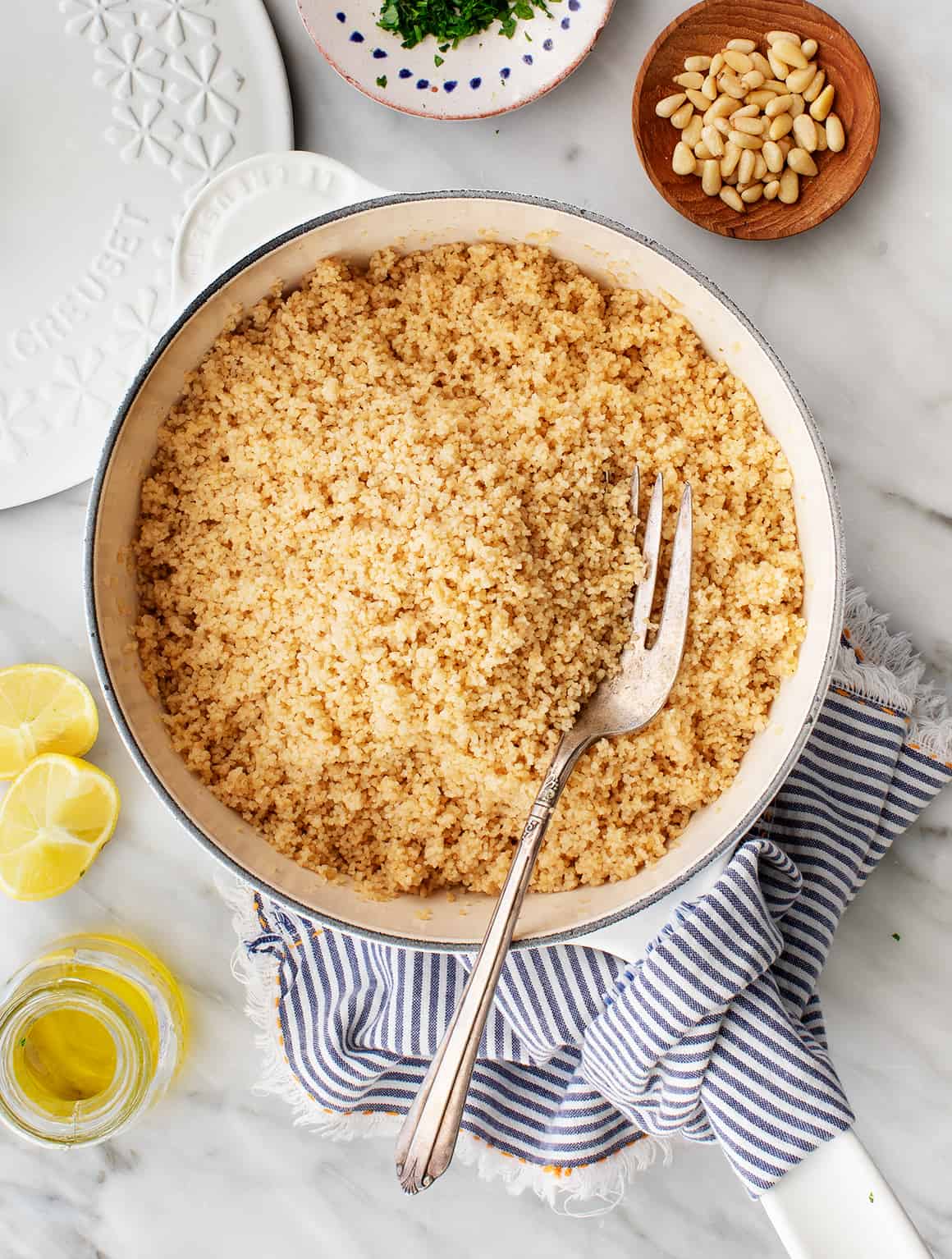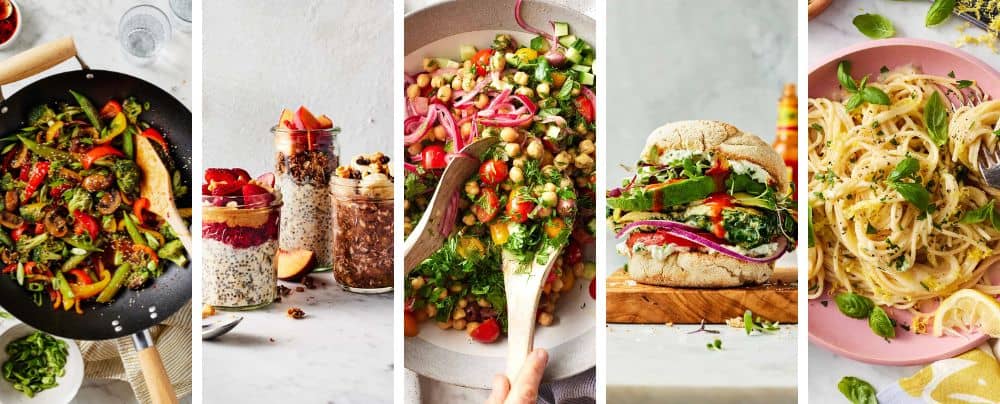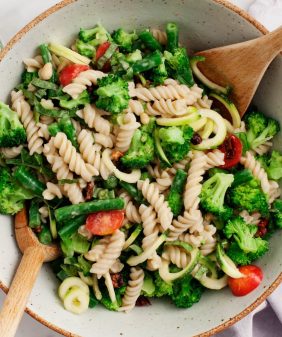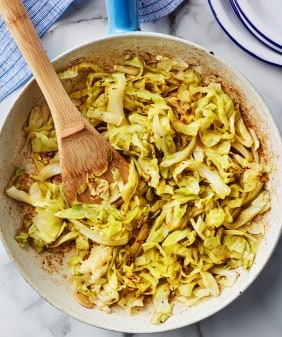Learn how to cook couscous! Toss this tiny pasta with herbs and lemon to make a simple side dish, or try one of the couscous recipes suggested below.

If you open up my pantry, you’ll almost always find a box of couscous inside. I love keeping this quick-cooking starch on hand, as it’s an easy side dish that pairs well with all kinds of meals. Because I’m such a big couscous fan, I thought I’d dedicate today’s post to discussing what it is and how to cook it. And of course, I’ll share some of my favorite couscous recipes!
First, what is couscous?
Couscous might seem like grain, but it’s actually a type of pasta. First made by the Berber people of North Africa, it’s made from rolled, sifted, and steamed durum wheat semolina, and it’s a staple food in North African cuisine.
Today, you can find couscous in a variety of shapes and sizes, ranging from tiny grains to larger pearls. Israeli couscous is also widely available in grocery stores. It looks a lot like traditional pearl couscous, but, according to this Food52 article, it’s not quite the same thing, as it was developed much later and is prepared slightly differently. However, because it’s so easy to find in grocery stores, I’m still including cooking instructions for it below.
How to Cook Couscous
How you cook couscous will depend on what type you buy. In grocery stores, you will most often find these two varieties:
- Traditional (white or whole wheat): As you can see in the picture above, this type of couscous is tiny – even smaller than quinoa! It would traditionally be steamed in a special pot called a couscoussier, but you can also quickly steam it in a regular lidded pot or saucepan. Measure a 1:1 ratio of couscous and water, and bring the water to a boil. When the water is boiling, add the pasta, cover the pot, and remove it from the heat. Let it stand for 5 minutes, covered, before you remove the lid and fluff with a fork. Though it’s not totally necessary, I also like to add a bit of olive oil and salt to the boiling water to add flavor and prevent clumping.
- Israeli: Instead of steaming Israeli couscous, I cook it like I do other kinds of pasta. I bring a large pot of salted water to a boil and add the pearl-like balls, cooking for 7 to 8 minutes, or until al dente. As soon as I drain it, I toss it with a large glug of olive oil so that the balls don’t stick together.
Can you cook couscous in a rice cooker?
Yes! If you prefer not to use the stove, using a rice cooker is another quick and easy way to cook traditional couscous. I recommend one of the popular models from Zojirushi, which has automatic settings for keep warm, extended keep warm, and reheating. You can use the regular white rice setting with a 1:1 ratio of grain to water (no worries—you can still add olive oil and salt to it like I suggest in the recipe below).
Couscous Recipes and Serving Ideas
Once you’ve cooked your couscous, you have all sorts of options for using it! Here are a few of my favorites:
- Add it to a salad. Try making this Mediterranean couscous salad with roasted tomatoes and chickpeas. You can also use it in place of quinoa, bulgur, or millet in a grain salad.
- Serve it as a side dish. Below, you’ll find my favorite way to prepare this tiny pasta as a simple side dish. I toss it with herbs, lemon juice, pine nuts, and olive oil to make a bright, refreshing pilaf. It pairs nicely with any protein, vegetable main dish, or soup!
- Top it with a stew. Traditional Moroccan couscous is often served with stewy seasonal vegetables, and I adore this preparation. Find my riff on North African tagine on page 207 of Love & Lemons Every Day!
- Make it a meal on its own. Make the recipe below. Then, top it with roasted veggies like cauliflower, Brussels sprouts, or butternut squash, drizzles of tahini sauce, and your favorite protein to make an easy meal!
Enjoy!
More Basic Grains and Starches
If you love this recipe, try making one of these grains or starches next:
- Herbed Farro
- Instant Pot Quinoa
- Creamy Polenta
- Perfect Brown Rice
- Instant Pot Brown Rice
- Stovetop White Rice
- Forbidden Black Rice
- Wheat Berries

Lemon Couscous Recipe
Equipment
Ingredients
- 1 cup water
- 1 cup couscous
- 4 teaspoons extra-virgin olive oil
- ¾ teaspoon sea salt
- 2 garlic cloves, minced
- Zest of 1 lemon
- 1 tablespoon fresh lemon juice
- ⅓ cup minced fresh parsley, plus more for garnish
- 2 tablespoons pine nuts, plus more for garnish
- Red pepper flakes, optional
Instructions
- In a medium saucepan, bring the water to a boil. Add the couscous, 1 teaspoon of the olive oil, and ½ teaspoon of the salt and stir. Cover, remove from the heat, and let stand for 5 minutes.
- Fluff the couscous with a fork, transfer it to a large bowl, and toss it with the remaining 1 tablespoon olive oil, the remaining ¼ teaspoon sea salt, the garlic, lemon zest, lemon juice, parsley, and pine nuts.
- Transfer the mixture to a serving platter and garnish with additional pine nuts, parsley, and red pepper flakes, if desired.
















Absolutely delicious, super easy!! Will be making again!!
Absolutely perfect recipe! My wife and I just started the mediterranean diet and neither of us had ever eaten Couscous. Followed this recipe to the letter and my wife and I couldn’t stop talking about it.
Thanks for the recipe!!!
Can you leave out the pine nuts?
Absolutely or substitute pistachios or almonds.
Silly question: this calls for raw garlic, right? I’m a little scared of raw garlic so I confess I omitted it out of uncertainty but it was still delicious and is going to be my go-to couscous. 🙂
I paired with salmon with just salt/pepper/butter and a little dill and it was lovely. Thank you!
I’m so glad you loved the recipe! Yep, it calls for raw garlic. Feel free to omit it in the future or add it in—the warm couscous will cook it slightly.
You could probably use garlic powder or roasted garlic is what Im going to try.
I have never had anything like this…. Sooooo very refreshing!!!! Will be a weekly dish!!! Thank You for this recipe! Wouldn’t change a thing. It is perfection!
I’m so glad you loved it!
I’ll definitely come for more
ammoandsupply.com/product/remington-9-1-2-primers
My family and I really enjoyed eating it
ammoandsupply.com/product/large-rifle-magnum-primers/
It really sounds like a great meal hammoandsupply.com/product/large-rifle-magnum-primers
I’ll be so delighted to eat it
Soooooo lemony & delicious. Add the red pepper flakes!
Loved this! Although i skipped the pine nuts and fresh parsley and just used dried parsley for color. I paired it with grilled salmon seasoned with tamarind powder and thyme. Delish!
Sounds like a great meal, Jas! So glad you enjoyed the recipe.
I am not a fan of pine nuts, would you recommend a substitution that has some crunch ?
Hi Eva, you can skip them or toasted pistachios would be nice.
toasted slivered almonds would be great!
I love this dish
I used veggie broth ..my guest is vegetarian
She ….we really liked it
She asked for the recipe
Thanks so much
Hi Lynda, so glad it was a hit!
I doubled this recipe so it was kind of hard to fit it all in one of my skillets. I was hoping it was enough sauce because I added a zucchini and a jalapeno. With additional peppers red orange and yellow. I served with a lemon couscous recipe very delicious.
This has been a long time favorite! I would like to ask if you have a favorite (s) trusted olive oil as I’ve heard that we Americans are being duped with some brands that aren’t the ‘pure’ good stuff?
Thanks!
Hi Norm, I like California Olive Ranch!
I always look for olive oil from California. Sometimes it is blended with imported, but should be on the label. Always a better favor to me.
Greek olive oil…. Its the best tasting and never blended.
Here are my go-to’s! Graza (Spainish olive oil) or Kosterina (Greek olive oil). I love both.
This is delicious! I did use no chicken broth instead of water. That’s the only change. I was eating it by the spoonful haha
I’m so glad you enjoyed it!
No chicken broth?
It’s a vegetarian chicken broth substitute!